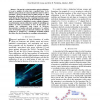Free Online Productivity Tools
i2Speak
i2Symbol
i2OCR
iTex2Img
iWeb2Print
iWeb2Shot
i2Type
iPdf2Split
iPdf2Merge
i2Bopomofo
i2Arabic
i2Style
i2Image
i2PDF
iLatex2Rtf
Sci2ools
120
Voted
IROS
2009
IEEE
2009
IEEE
Fault-tolerant formations of mobile robots
—The goal of a robot formation control architecture is to get a number of robots into a specified form. To be effective and practical, the control architecture must be able to transition a group of robots from an initial swarm to a final formation. It must then be able to handle real-world events that could disrupt the formation, thus, requiring formation repair, obstacle avoidance, and changes in the formation. In previous work, we presented a distributed, reactive cellular automatabased formation control architecture capable of controlling any number of robots in formation at once. In this paper, we examine our architecture with respect to necessary characteristics to handle real-world occurrences. To address issues of formation repair and obstacle avoidance, the control architecture is extended by a distributed auctioning method that allows the robot formation to reconfigure autonomously.
Related Content
| Added | 24 May 2010 |
| Updated | 24 May 2010 |
| Type | Conference |
| Year | 2009 |
| Where | IROS |
| Authors | Ross Mead, Robert Long, Jerry B. Weinberg |
Comments (0)

